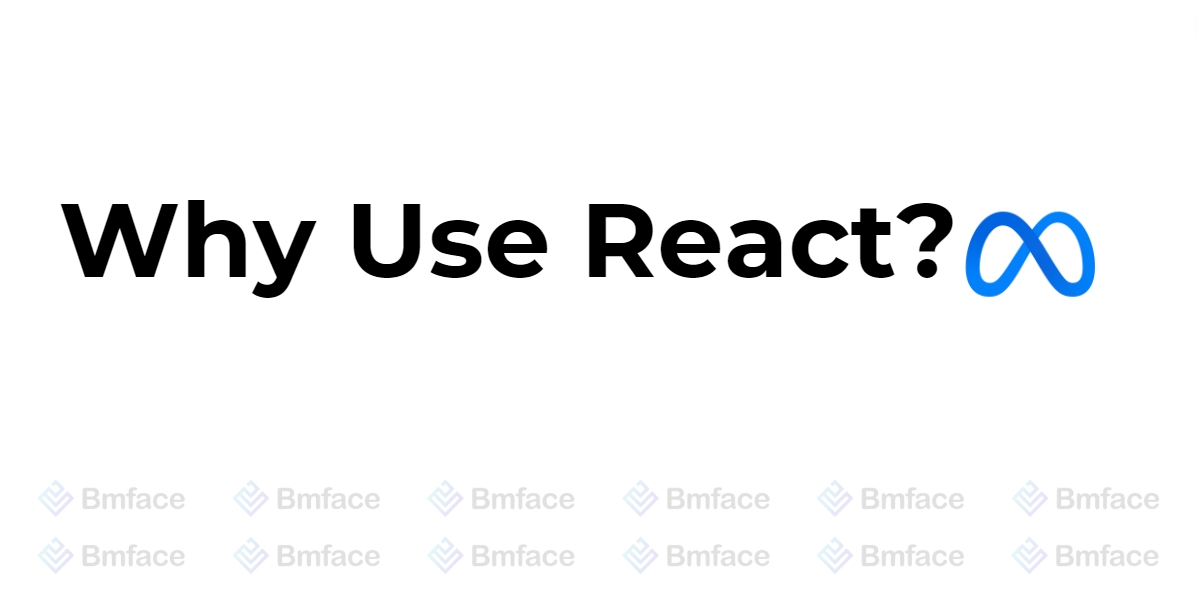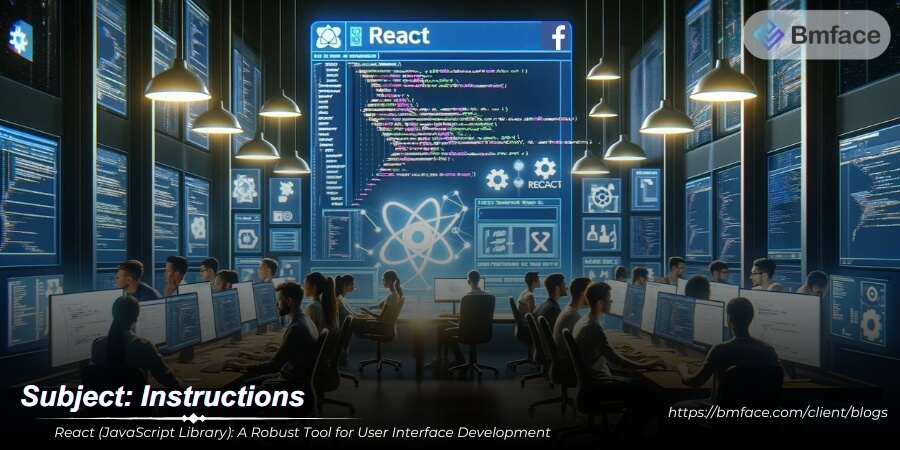Developed and maintained by Facebook, React has become a cornerstone in the world of modern web development. This JavaScript library is specifically designed for building user interfaces, with a particular focus on creating efficient single-page applications (SPAs). This article by BMface helps you explore the key features and advantages of using React, shedding light on why React is a great choice for developers looking to create dynamic and responsive web applications fast.
What is React?

1, Key Features of React
- Declarative UI: React makes it easy to create interactive UIs. Design simple views for each state in your application, and React will efficiently update and render just the right components when your data changes. This declarative nature makes your code more predictable and easier to debug.
- Component-Based Architecture: Build encapsulated components that manage their own state, then compose them to make complex UIs. Since component logic is written in JavaScript instead of templates, you can easily pass rich data through your app and keep the state out of the DOM.
- Learn Once, Write Anywhere: React doesn’t make assumptions about the rest of your technology stack, so you can develop new features in React without rewriting existing code. React can also render on the server using Node and power mobile apps using React Native.
- Virtual DOM: React creates a virtual DOM in memory, where it does all the necessary manipulating, before making the changes in the browser DOM. This optimized approach makes updates smoother and faster, improving performance and user experience.
5. JSX: JSX is a JavaScript syntax extension that looks similar to XML. You can use JSX to write HTML structures in the same file that contains JavaScript code. This makes the code easier to understand and debug, as it avoids the usage of complex JavaScript DOM structures.
2, Advantages of Using React
- Fast Learning Curve: React is relatively easy to learn and understand, especially for those with a background in JavaScript.
- Reusable Components: Developers can reuse code components in different parts of their application, which can significantly speed up the development process.
- Rich Ecosystem: A large community and plethora of third-party extensions make React a flexible choice for developing a wide array of applications.
- Strong Community Support: Backed by Facebook and other influential tech companies, React has a massive community and comprehensive documentation.
3,Applications of React
- Single-Page Applications (SPAs): React is ideal for developing SPAs where all necessary code—HTML, JavaScript, and CSS—is retrieved with a single page load, or the appropriate resources are dynamically loaded and added to the page as necessary.
- Mobile Applications: With React Native, the same design principles of React can be used to build mobile applications that compile to native app code.
- Web Applications: React's efficiency in updating the smallest parts of the UI without affecting others makes it suitable for enterprise-level applications that handle complex data changes frequently and have significant user interaction.
React continues to evolve, with regular updates from Facebook and contributions from the community. Its ability to combine functionality with efficiency makes it a preferred choice for developers looking to build dynamic, high-performing applications. As web development trends lean towards more dynamic and interactive user interfaces, React's popularity and relevance are likely to continue growing.
Core Features of React

1, Virtual DOM
Optimized Performance: React introduces the concept of the Virtual DOM, which is a lightweight copy of the actual DOM. This feature allows React to manage a virtual representation of the UI that is kept in memory and synced with the real DOM by a reconciliation process known as diffing. When a component’s state changes, React first updates the Virtual DOM, then only modifies the real DOM nodes that have changed. This minimizes the performance cost of updates and offers a more efficient way to manage UI manipulations.
2, One-Way Data Binding
Predictable and Controlled State Management: React follows a unidirectional data flow or one-way data binding, where the data in your application follows a single path. This makes the application easier to understand and debug because it reduces side effects. In React, the state is typically owned by specific components that update it, and only specific components that need the data receive it, minimizing direct manipulation of the DOM and ensuring that the data flows through the application in a predictable manner.
3, Declarative UI
Simplified Debugging and Testing: React's declarative nature makes it simpler to describe what the UI should look like for a given state of the application. This approach minimizes side effects and unexpected behavior, making the code more predictable and easier to debug. When you write a React component, you’re essentially creating a blueprint for the view based on the given properties and state, allowing React to handle updates and rendering efficiently.
4, Composition Model
Enhanced Code Stability and Reuse: The component-based architecture of React allows developers to build high-quality, encapsulated components that manage their own state, then compose them to make complex UIs. Components receive props as a single set of immutable values, which can include callbacks that allow components to communicate with each other. The composition model gives developers the flexibility to reuse code and extend components without needing to modify their internals, enhancing code stability and maintainability.
5, Learn Once, Write Anywhere
Cross-Platform Development: React's design doesn’t make assumptions about the rest of your technology stack, so it’s possible to develop new features in React without rewriting existing code. React can also render on the server using Node.js and power mobile apps using React Native, a separate version of React that uses native components instead of web components as building blocks.
React’s core features not only provide the technical foundation for building dynamic and responsive web applications but also promote best practices in web development. By embracing a component-based architecture, leveraging the Virtual DOM, and ensuring a declarative UI, React helps developers create scalable and maintainable applications. Its strong ecosystem and continuous development underpin its popularity and effectiveness as a front-end library.
Why Use React?

1, Component-Based Architecture
Reusable Code: In React, you build encapsulated components that manage their own state, then compose them to make complex UIs. This modularity enables reusability, which simplifies your development process and increases the efficiency of updates.
2, Declarative UI
Simplify Code and Increase Readability: React's declarative nature makes it straightforward to reason about your application. It makes your code more predictable and easier to debug. You describe UIs as you want them to appear, and React ensures the data changes reflect in the component renderings without additional effort.
3, JSX Syntax
Enhanced Development Experience: JSX is a syntax extension for JavaScript that resembles HTML. It makes writing your React components' structure with the full power of JavaScript more accessible and maintainable. JSX compiles to JavaScript, providing performance benefits and keeping the syntax concise and familiar.
4, Strong Community and Toolset
Robust Ecosystem: React's community is one of its greatest strengths. There's a vast array of libraries, tools, and extensions available that make React development more accessible, efficient, and powerful. From state management solutions like Redux and MobX to development tools like Create React App and Next.js, React’s ecosystem is both vibrant and supportive.
5, Seamless Integration with Other Tools
Flexibility in Development: React plays well with other libraries and frameworks, not requiring a full commitment to a specific technology stack. This flexibility allows it to integrate smoothly into existing projects or alongside other tools, enabling developers to adopt React at their own pace or as needed for specific parts of their projects.
6, Future-Proof Technology
Continuous Improvements and Adaptations: React is maintained by Facebook and a community of developers, ensuring it stays up to date with the latest in performance optimizations and web development trends. It supports modern development practices and prepares your projects for future web standards.
React stands out in the modern web development landscape for its efficiency, flexibility, and strong community support. Its approach to building applications through reusable, declarative components, and efficient data handling through the Virtual DOM and one-way data flow, makes it a compelling choice for developers aiming to build scalable and maintainable web applications. Whether developing new applications or integrating into existing projects, React provides the tools necessary to create dynamic and responsive user experiences.
Applications of React in Web Development
1, Interactive User Interfaces (UIs)
Dynamic Interactions: React's reactive data flow is perfect for creating interactive UIs where the interface needs to respond to user actions in real time. Examples include dynamic forms, charts, and dashboards, where the UI updates efficiently as users interact with the application.
2, Real-Time Applications
WebSockets and React: For applications that require real-time data updates, such as chat applications or live content streaming platforms, React's efficient update mechanism pairs well with WebSockets to provide a seamless real-time experience. React can handle frequent state updates that reflect instantly in the UI without performance degradation.
3, E-commerce Platforms
Robust and Scalable: React's component-based structure makes it suitable for building large-scale e-commerce platforms. Developers can create reusable components like product lists, carts, and filters, which can manage their own state and coexist independently, leading to highly maintainable code.
4, Data Visualization
Integration with D3.js and Other Libraries: React can integrate with powerful data visualization libraries like D3.js, enabling the creation of interactive graphs and complex visualizations that are both responsive and efficient. This capability is crucial for analytics dashboards that process and display complex datasets in understandable ways.
5, Enterprise Applications
Complex Systems Simplified: For enterprise-level applications, React's scalability and component modularity allow large teams to collaborate more effectively. React's context API and state management libraries like Redux or MobX can manage global state across large app ecosystems without frequent props drilling or complex callbacks.
6, Progressive Web Apps (PWAs)
Service Workers and React: Combining React with Service Workers enables developers to build Progressive Web Apps that can load instantly and provide offline experiences, push notifications, and background data sync. This makes React a great choice for applications aimed at performance and reliability on unstable networks.
7,Educational and Interactive Learning Platforms
Engagement and Accessibility: React is used to develop educational platforms that require a high degree of user interaction and accessibility. Its ability to handle complex state management and updates makes it suitable for scenarios where users must interact with educational content, such as simulations, quizzes, and learning management systems.
React's flexibility and robust ecosystem make it suitable for a wide array of web development projects from small projects to enterprise-level applications. Its ability to integrate seamlessly with other technologies and libraries, combined with its strong component lifecycle management, ensures that React is a formidable choice for any developer looking to build efficient, maintainable, and scalable web applications. Whether you are building a single-page application, a complex enterprise solution, or anything in between, React provides the necessary tools to create an effective and engaging user experience.
Best Practices for Using React
1, Code Reusability and Modularity
- Component Reuse: Design your components to be reusable across different parts of the application or even across different projects. This not only speeds up development time but also helps in maintaining consistency throughout your applications.
2, Component Composition
- Building Complex Interfaces: Leverage React's compositional nature to build complex interfaces by nesting smaller, simpler components within larger ones. This hierarchical structuring makes managing complex UIs simpler and more efficient.
3, Prop-Driven Development
- Control Components via Props: Use props to control components. This technique allows you to pass data and event handlers to child components, making them more dynamic and reusable in different contexts.
4, Lifecycle Management
- Effectively Use Lifecycle Methods: Understand and use React's lifecycle methods appropriately to manage side effects, fetch data, and manipulate DOM when necessary. Hooks like
useEffectprovide these capabilities for functional components, offering more control with cleaner code.
5, Type Checking with PropTypes or TypeScript
- Enhance Code Quality: Implement type checking in your React projects. Using PropTypes or TypeScript can help prevent bugs and improve the maintainability of your code by ensuring you work with the right data types.
6, Error Boundaries
- Graceful Error Handling: Use error boundaries to catch JavaScript errors anywhere in a component tree, log those errors, and display a fallback UI instead of crashing the entire component tree.
7, Avoid Inline Function Definition in the Render Method
- Optimize Performance: Define functions outside the render method or use
useCallbackto avoid unnecessary re-renders caused by different function instances being created on each render.
8, Use Fragment to Avoid Additional HTML Element Wrappers
- Simplify DOM Structure: Use React Fragments to group a list of children without adding extra nodes to the DOM. This can be crucial for maintaining a clean and efficient DOM structure.
9, Testing and Continuous Integration
- Ensure Reliability: Implement testing strategies using tools like Jest and Enzyme or React Testing Library to write unit and integration tests for your React components. Continuous integration practices help in maintaining code quality and robustness.
10, Accessibility (a11y)
- Build Inclusively: Pay attention to accessibility by using semantic HTML and ARIA roles where appropriate. React's flexibility with JSX allows for the seamless integration of accessibility features directly within your components' markup.
Conclusion
React provides a rich set of features that, when used according to best practices, can significantly enhance the performance, maintainability, and scalability of web applications. These practices are essential for any developer looking to leverage React's full potential effectively. As the library continues to evolve, staying updated with the latest features, patterns, and community best practices will be key to leveraging React efficiently in your projects.
For more insights and updates on effective social media strategies, make sure to follow Bmface and our tutorial blog, where we share the latest and most effective content marketing tips.
Cảm ơn bạn đã theo dõi bài viết. Mua hàng tại Bmface.com để ủng hộ đội ngũ Admin viết thêm nhiều bài viết hay. Xin cảm ơn!
































